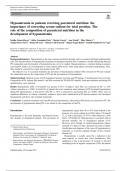Autre
Hyponatremia in patients receiving parenteral nutrition: the importance of correcting serum sodium for total proteins. The role of the composition of parenteral nutrition in the development of hyponatremia Emilia Gómez-Hoyos1 ● Silvia Fernández-Peña1 ● Ma
- Cours
- Établissement
Hyponatremia in patients receiving parenteral nutrition: the importance of correcting serum sodium for total proteins. The role of the composition of parenteral nutrition in the development of hyponatremia Emilia Gómez-Hoyos1 ● Silvia Fernández-Peña1 ● Martín Cuesta2 ● Ana Ortolá1...
[Montrer plus]



